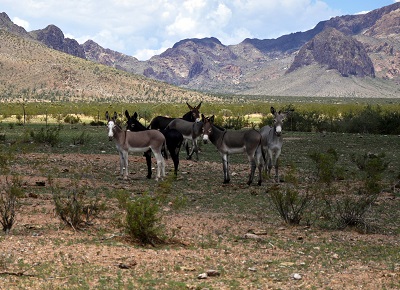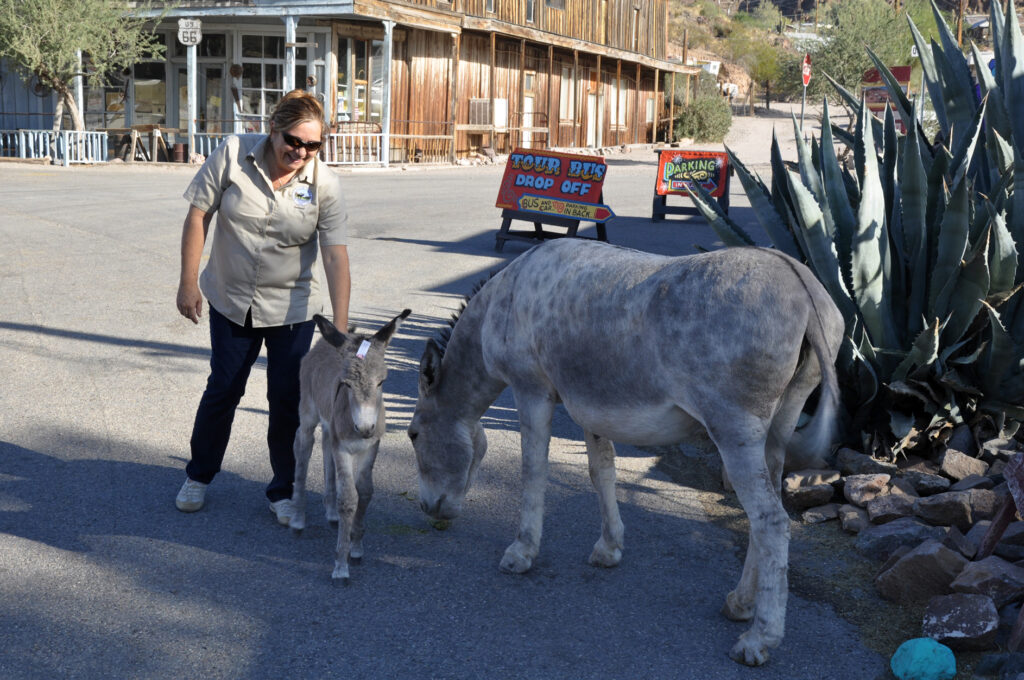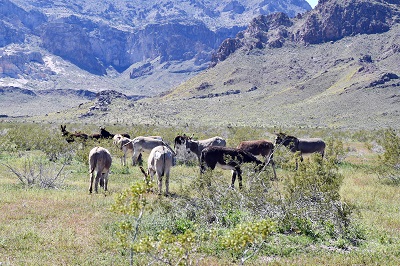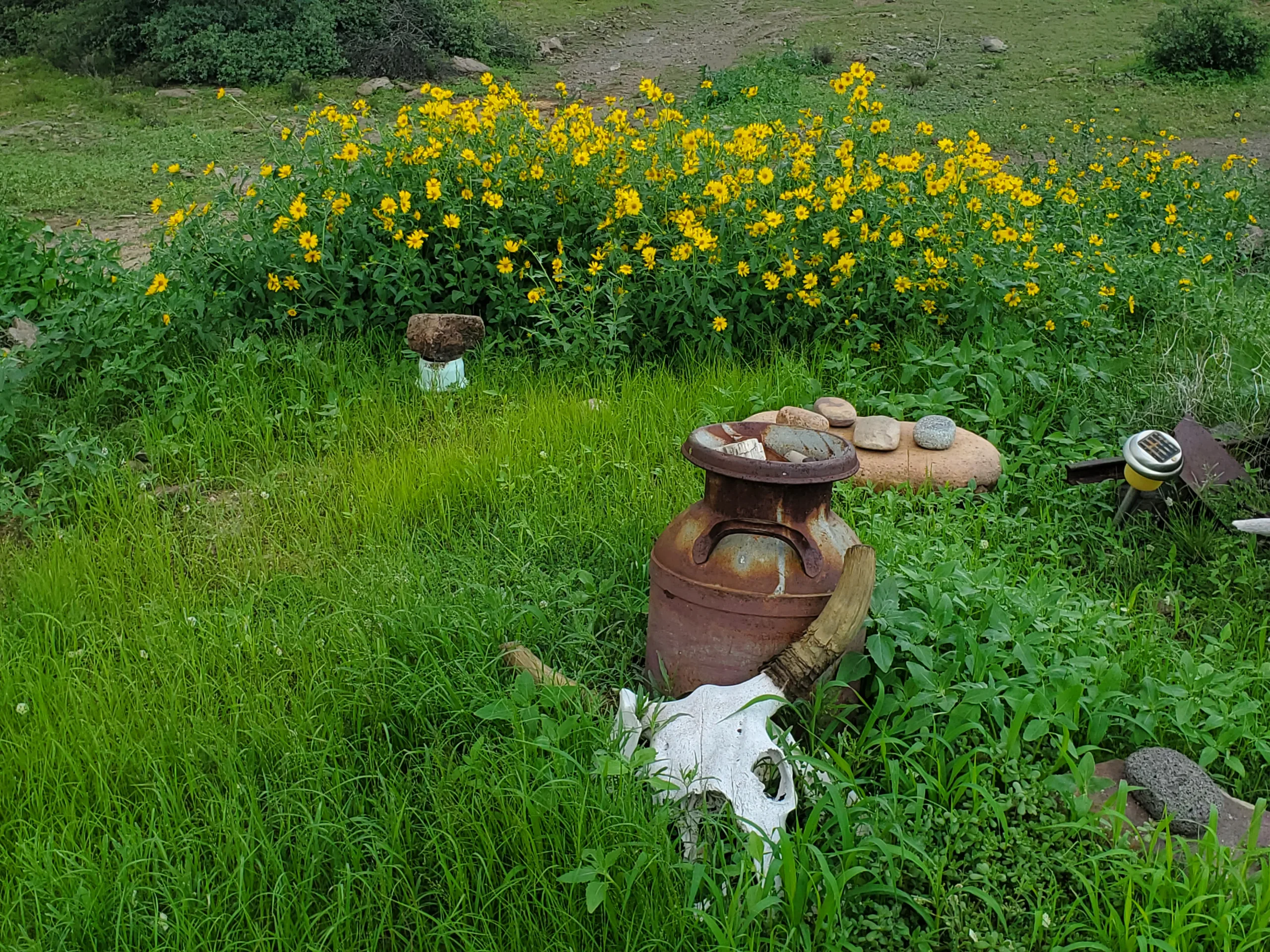
Dear Editor,
The largest Bureau of Land Management (BLM) roundup utilizing helicopters on the 2024 scheduled capture of burros kicked off this month in the Black Mountain Herd Management Area (HMA) nestled between Kingman and Bullhead City.
The use and inhumane-method of helicopters to roundup wild burros and horses equals danger and great financial expense, and results in: trauma, injuries family bands torn apart and even deaths.
The wild, free-roaming wild horses and burros can be found on public lands across the western states, including Nevada, California, Utah, Idaho, Oregon and Arizona.
Broadly, U.S. law declares free-roaming wild horse and burros to be “living symbols of the historic and pioneer spirit of the West,” and stipulates that the BLM and the U.S. Forest Service have the responsibility to manage and protect herds in their respective jurisdictions within areas where wild horses and burros were found roaming in 1971.
According to the BLM website, “…free-roaming wild horses and burros living today are descendants of animals that were released or escaped from Spanish explorers, ranchers, miners, the U.S. Cavalry and Native Americans…”
BLM says the purpose of the “gather” is to address an overpopulation of wild burros within the Black Mountain HMA to achieve a thriving natural ecological balance, alleviate deterioration of the rangeland as well as to address public safety and private property concerns.
The gather will allegedly addresses human health and safety concerns within the local area related to vehicle collisions with burros on the roadways and damaging private property. For these reasons, local municipalities in Mohave County supposedly requested that the BLM address the wild burro overpopulation in the Black Mountains.
“Because the BLM sets unnaturally low population limits for wild burros in the Black Mountain HMA to maximize public lands available for private, taxpayer subsidized livestock grazing,” said Golden Valley resident Dan Hammerstein, “they opt to drive wild burros from their homes, and into incarceration, causing injuries and even death each year.
“When BLM mentions ‘rangeland,’ they hit the preverbal nail on the head. It’s all about rangeland and, of course revenue,” Hammerstein said. “BLM doesn’t receive any funds for the burros, but if they (burros) are not there, that leaves more area for cattle to graze.” And besides, BLM receives money to allow cattle to graze on Public Lands.
Grazing fees dictate the price per “animal unit” (AU) — one cow and calf, one horse or five sheep — per month. The fees apply to roughly 18,000 BLM grazing permits and leases and 6,250 Forest Service permits (that’s the number of ranchers, not just cattle); income is funneled to range land betterment funds, the U.S. Treasury, and those states where the grazing occurs.
According to BLM, inflation may be at a 40-year high, but the cost of grazing livestock on public lands is lower today than it was 40 years ago. BLM and Forest Service federal rate is just $1.35 per AU. In addition, ranchers in Arizona also pay a surcharge of $3.03 per AU – that equates to the BLM receiving $4.40 AU the ranchers pay to graze on Public Lands each month for each animal.
Accordingly, BLM and Forest Service are committed to strong relationships with the ranching community and work closely with permit holders to ensure public rangelands remain healthy, productive working landscapes. The grazing fee applies in 16 Western states on public lands administered by the BLM and the Forest Service.
“No wonder they want to get rid of burros,” said another Golden Valley resident who wanted to remain anonymous because their relative works for BLM. “Less burros, more cows, which in turn, means more money in BLM’s pockets?”
BLM speaks of burro vehicle-accidents, but fails to mention there are more cow-vehicle accidents that occur in Mohave County. The reason for this is Arizona is deemed open range and the cattle can roam anywhere they want, even on Highways 68, 95 and 93. If a cow wonders onto the roadways and a vehicle hits and kills it, the driver of the vehicle has to pay the rancher anywhere from $750 to $1,500.
There have been numerous allegations that have surfaced of abuse and/or death of the aforementioned animals during the government’s roundups of horses and burros. BLM say the roundups have been conducted in order to maintain a certain number of them in specific areas.
The Black Mountain HMA covers nearly 1.1 million acres of public, state, tribal, and private lands in Mohave County in northwestern Arizona. The Appropriate Management Level (AML) for the Black Mountain HMA is only 478 wild burros. This number was set with a meeting of various individuals, the U.S. government representatives and groups such as The Mohave Sportsmen.
Outdoor writer and hunting guide Don Martin, is associated with The Mohave Sportsmen, and was one of the many who participated in the Black Mountain Ecosystem Management Plan meetings.
In addition to being a hunting guide, Don Martin has been testing the waters to run for the Mohave County District 4 Supervisor position.
The main reason why Martin wants to limit the numbers of burros in the Black Mountains is because he feels they take away from the natural vegetation and fauna available to the Big Horn Sheep and deer. He also makes a living by guiding those who want to trophy hunt.
A straw poll of more than 100 Golden Valley residents (East of the Black Mountains) was recently conducted and none of them want the burros captured. They all said they want BLM to stop harassing and capturing the burros; they enjoy seeing the burros wonder throughout the area.
“My husband and I owned and ran a large rescue in Minnesota. We were nationally registered as “The Original Funny Farm Donkey Rescue,” said Golden Valley resident Joani Mogensen. “We worked with the Minnesota Board of Animal Health, and we rescued many donkeys with BLM brands on them, from feed lots (slaughter houses) and less than reputable animal auctions.
“I moved into Golden Valley because the burros would visit my property,” Mogensen said. “So if Martin was part of the group that advocates capturing burros, I will not vote for him to become a Mohave County Supervisor.”
Burros and donkeys are the same species. Sometimes the word burro is used to describe a specific type of donkey that is smaller and has longer hair than do standard donkeys.
There are also some people who are not too keen on the burros residing in the Black Mountains and don’t like living in harmony with the burros even though they reside elsewhere. Those are mostly County residents who reside on the western side of the Black Mountains, such as Laughlin Ranch in Bullhead City.

64,588 wild horses and burros are in government holding facilities such as Florence, AZ, and Ridgecrest, CA.
Penny Pew, the Congressman Paul Gosar’s District Director and Intergovernmental Affairs at the U.S. House of Representatives, was recently asked at Conservative Republican Club of Kingman event by a constituent about the burro population and roundup in the Black Mountains. Pew reportedly said, “They need to round them up, because they are starving.” That can be no further from the truth.”
Jennifer Esposito, a candidate for Mohave County District 4 Supervisor, the woman who asked Pew the question regarding burros, told her, “We bought our property in Golden Valley partially because it was close to the Black Mountains’ trail head and we love that the wild burros would come and visit us.
“I have never seen a starving burro in the Black Mountains or Golden Valley; they are all happy and healthy,” Esposito said. “I want Congressman Gosar to stop the horrific helicopter roundups. American Horse Campaign advocates for humane treatment of all wild horses and burros by the BLM and hold them accountable by filming roundups and publishing reports of their horrific means of capture.”
The prior capture of burros in the Black Mountains was completed in March 2023 where more than 80 burros were rounded up using bait pens.
After capture, horses and burros are immediately sorted and split from their families, and they cry out for their family members as they’re cruelly separated.
Reports as of 2023 show there are 64,588 wild horses and burros in government holding facilities such as Florence, AZ, and Ridgecrest, CA.
BLM targets 1,000 burros from the Black Mountains and surrounding area during their most recent gathering, and (if the target is hit) will release 100 treated females with porcine zona pellucida (PZP).
PZP is a glycoprotein membrane that surrounds all mammalian eggs. Certain proteins in the membrane serve as the sperm receptor. The contraceptive vaccine produced by the SCC uses the ZP from the pig, thus the name porcine zona pellucida (PZP).
The PZP vaccine is usually given, initially, in a series of 2 part vaccinations 2-6 weeks apart and then a booster every 8 months to a year, depending on the species. The PZP is emulsified with an adjuvant to stimulate the animal’s immune system.
According to BLM, the roundup is targeting areas where human encroachment has caused burros to congregate. Recreational users and tourists visit the area and will often feed burros. When they leave, human presence apparently keeps burros coming in thinking they will get an easy meal. These concentrations are causing conflict, including increased vehicle collisions.
The Appropriate Management Level (AML) for the Black Mountain HMA is only 478 wild burros. As of 2024, the estimated population is approximately 1,925 burros, which does not include the foals born this year. The current population estimate, including the 2023 foal crop, puts the HMA at approximately 1,447 wild burros over AML.
BLM is using helicopter drive trapping. What is concerning about “capture stress” is burros are more susceptible, and past roundups have shown high mortality rates after capture. Burros are not horses. That statement applies not only to the outdated way burros are managed on range (using modeling for horses), but it also applies to capture and how they are fed and handled post-capture.
News sources, individuals and groups who have monitored the horse and burro roundups have said that many of the animals, especially horses, have died or were critically injured due to the government agencies chasing them with fixed-wing aircraft and helicopters during the roundups of horses and burros.
According to those who have monitored the roundups, 23 horses were injured, euthanized and/or died during the last roundup in Nevada.
BLM’s Adoption Incentive Program took effect three years ago, and more than 1,000 wild horses and burros were sold during livestock auctions.
Many of those older horses and burros that were not adopted or allegedly sold were shipped off to slaughter houses in Oklahoma, Texas and Kansas for processing; and exported to Canada, Mexico and the United Kingman.
The BLM refuses to acknowledge if there are BLM-branded horses and burros that have ended up in slaughter house pens. Furthermore, BLM and other government agencies have not said if investigations have been conducted to determine if there is criminal activity in regard to adopting wild horses and burros and then selling them to slaughter houses.
“Wild horses and donkeys, once adopted from BLM, are never supposed to be in those horrendous, inhuman situations by being sold at auctions and to slaughter houses,” Mogensen said. “There is a specific clause in the BLM adoption application. “I and others would like to know if adopters who have failed to follow the BLM bylaws, were charged with crimes,” Mogensen stressed.

Nevada Congresswoman Dina Titus takes BLM to task
Nevada Congresswoman Dina Titus wants to put a stop to the use of helicopters in roundup of horses and much more. She has worked on measures to manage and protect the mustangs since her days in the State Legislature, but says a particular image was the last straw for her.
It’s the image of a colt, trying to escape from a helicopter despite a broken leg. The horse had to be euthanized, as did others during a recent Nevada roundup.
“I’m not saying you don’t need to manage wildlife on BLM land or forest service land throughout Nevada, but there’s got to be a better way to do it than running them into a canyon with a helicopter,” Titus said.
Images like the one that mobilized Titus are harder to come by in recent years. The BLM makes sure that public observers are kept far away from the actual roundups as they have with the most-recent burro roundup in Mohave County.
Dina Titus, a member of the Congressional Animal Protection Caucus, reintroduced the bipartisan Wild Horse and Burro Protection Act of 2023, along with Reps. David Schweikert (R-AZ) and Steve Cohen (D-TN). The act is currently in committee.
“My legislation would eliminate the use of helicopters in BLM wild horse and burro gathers and require a report to explore the benefits of alternative aircraft for humanely gathering horses and the workforce opportunities for traditional cowboys,” Congressman Titus said. “I am proud to introduce this bipartisan proposal that would protect these icons of the American West which remain a source of pride for Nevada residents.”
“I am proud to co-sponsor and support this important legislation that protects wild horses and burros from dangerous roundups that too often put the lives of these animals at risk,” said Rep. Schweikert. “The Wild Horse and Burro Protection Act encourage humane and cost-effective alternatives to capture wild horses and burros, and ensure they can continue to flourish in Arizona and other western states.”
“I am pleased again to join Congresswoman Titus in introducing this measure to protect wild horses and burros by discouraging the use of helicopters in roundups and encouraging greater use of fertility control drugs on these iconic animals by the Bureau of Land Management,” said Rep. Cohen, a member of the Congressional Animal Protection Caucus.
“We applaud Congresswoman Titus, Congressman Schweikert, and Congressman Cohen for their leadership in protecting our nation’s wild horses and burros. Reforms are long overdue to the Bureau of Land Management’s failed management approach, which involves stampeding panicked horses through helicopter roundups. These roundups are cruel, expensive, and ultimately ineffective at stabilizing populations. Wild equines deserve to be managed safely and humanely in their natural habitats for Americans to enjoy,” said Dr. Joanna Grossman, Equine Program Director and Senior Advisor for the Animal Welfare Institute.
“We are thankful to wild horse champions Congresswoman Titus, Congressman Cohen, and Congressman Schweikert for standing up for our nation’s wild horses and burros. Roundups are inhumane and cost U.S. taxpayers millions of dollars each year. Grounding these helicopters and utilizing more humane methods of managing wild horse populations on the range, such as fertility control vaccines, would go a long way toward protecting our wild horses and burros and saving tax dollars,” said Holly Gann Bice, Director of Government Relations for the American Wild Horse Campaign.
Congresswoman Titus submitted a statement to the BLM during 2023 as part of a public hearing to examine the use of motorized vehicles and aircraft in managing wild horses and burros.
“Scientific research shows that more humane and cost-effective alternatives exist to control equine populations, including fertility controls like the Porcine Zona Pellucida (PZP) vaccine, she stated. “ The BLM’s Wild Horse and Burro Program, however, currently spends less than one percent of its budget on fertility controls…”
In part, Congresswoman Titus wrote, “In January 2022, during a gathering at the Pancake Complex in central Nevada, a young colt was chased for miles by a helicopter, ultimately gravely injuring itself and necessitating the animal be put down. Sadly, it is not alone. Over the entire 2022 roundup season, a total of 120 horses were killed…”
“My husband and I donated to the American Wild Horse Campaign in response to this latest roundup.” Golden Valley resident and is running for Mohave County District 4 Supervisor Jennifer Esposito said. “They advocate for humane treatment of wild horses and burros by the BLM and hold them accountable by filming the round ups and publishing reports.”
According to Esposito, who is a staunch supporter of people’s rights, she told Penny Pew, the Congressman Paul Gosar’s District Director and Intergovernmental Affairs at the U.S. House of Representatives, that she was incorrect by saying the burros were starving. Esposito went on to her in the seven years she has been an owner of her Golden Valley property, she has never seen a single starving burro.
NOTE: A Freedom of Information Act (FOIA) request was mailed to the Bureau of Land Management (BLM) FOIA Office, in Washington, DC, during the later part of January 2023, and they received it on February 6, 2023.
The request was information regarding the inhumane-method of helicopters to roundup wild burros and horses, including the number of injuries and deaths.
Needless to say, Meriwether has never heard from or received anything from BLM except for the return receipt they signed when they received the request.
People may contact Butch Meriwether at meriwether@frontiernet.net regarding this or other subjects or call him at (928) 530-8988.
Butch Meriwether









